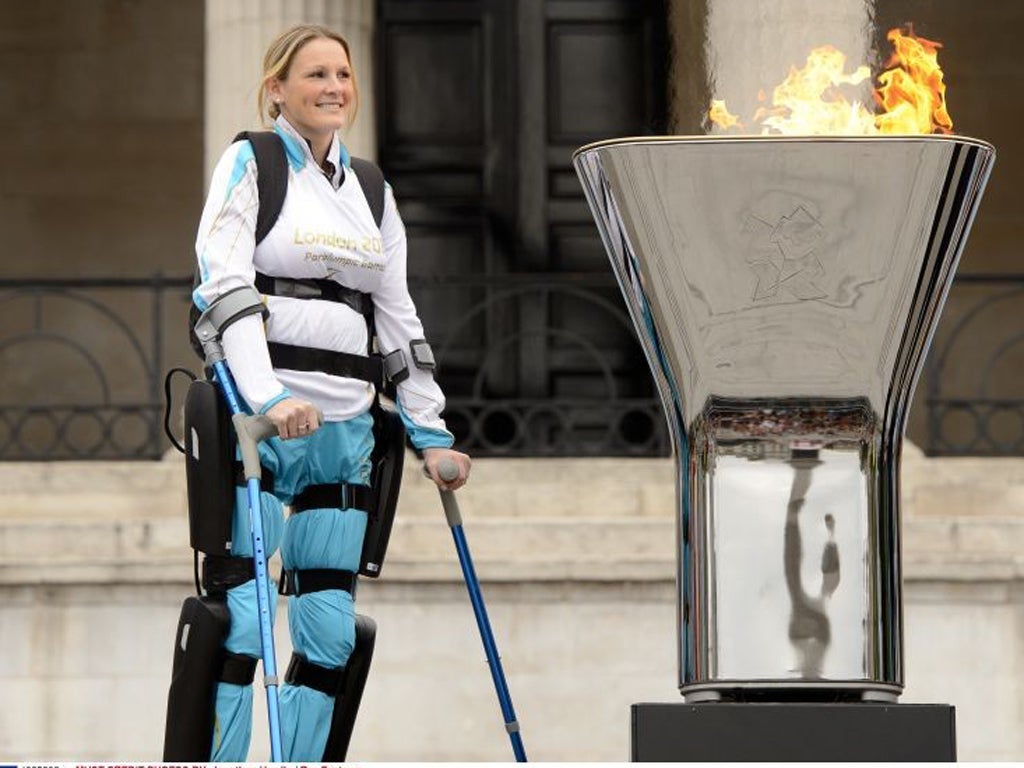'Bionic woman' Claire Lomas is first woman to take robotic suit home

Your support helps us to tell the story
From reproductive rights to climate change to Big Tech, The Independent is on the ground when the story is developing. Whether it's investigating the financials of Elon Musk's pro-Trump PAC or producing our latest documentary, 'The A Word', which shines a light on the American women fighting for reproductive rights, we know how important it is to parse out the facts from the messaging.
At such a critical moment in US history, we need reporters on the ground. Your donation allows us to keep sending journalists to speak to both sides of the story.
The Independent is trusted by Americans across the entire political spectrum. And unlike many other quality news outlets, we choose not to lock Americans out of our reporting and analysis with paywalls. We believe quality journalism should be available to everyone, paid for by those who can afford it.
Your support makes all the difference.A British woman paralysed from the chest down by a horse riding accident has become the first person to take home a robotic exoskeleton that enables her to walk.
Although bionic exoskeletons have been used in hospitals and rehabilitation centres, Claire Lomas is the first to take the ReWalk suit home for everyday use.
Lomas earlier this year used the suit to complete the London Marathon in 17 days, raising about £200,000 for research into spinal damage, and she was recently given the job of lighting the Paralympic cauldron in Trafalgar Square.
But she said more routine activities are equally gratifying.
"One of the best experiences was standing at a bar," she said. "To be stood up in this means everything to me."
Larry Jasinski, chief executive of Argo Medical Technologies, the company that developed the suit, told Reuters he was initially nervous about backing the marathon bid because the suit was still being tested but Lomas said it held up well.
"The suit was really reliable in the worst weather and I got there 17 days later," she said.
The exoskeleton is activated by the wearer tilting their balance to indicate the desire to take a step. It supports the body's weight and also allows the person to go up or down stairs, as well as sit or stand up independently.
It costs £45,000 and although clinical studies are ongoing that could back a case for health authorities to fund purchases of the device, the developers argue that savings on the treatment of ailments related to inactivity could offset the cost.
The company estimates that of the 6 million wheelchair users in the US and Europe, around 250,000 could be suitable for using the ReWalk device.
A report in 2010 by US firm ABI Research forecast the market for this technology could be worth $320 million within 10 years.
In the meantime, says Jasinski, the US and Israeli military have shown an interest for use by injured soldiers.
Research into exoskeletons goes back 50 years but advances in software management systems and sensors have only recently made them practical.
Argo, which is backed by Israeli venture capitalists SCP Vitalife and Israeli Healthcare Ventures, is working on a similar device for quadriplegics, as well as a brain interface that could allow more intuitive 'thought control' of the exoskeleton.
Although Jasinski says this is still years away, scientists have recently unveiled devices that can be controlled in real time by thought using advanced brain scanning.
Others are working on materials that can interact with human nerves and tissue that could eventually lead to prosthetics that are fused with the body and controlled directly by the nervous system.
In June, a team at Maastricht University in the Netherlands unveiled a device that uses functional magnetic resonance imaging, which monitors blood flow in the brain, to allow people to spell out words simply by thinking of each letter.
Another experiment reported in July saw FMRI used by a man at Bar-Ilan University in Israel to control the movements of a robot thousands of miles away at Beziers Technology Institute in France.
Lomas said that after her accident, she rejected pleas from doctors to give up on the idea of using her legs, saying that as a young, active woman before her 2007 accident, "I didn't want to have a big stomach and spindly legs".
Since the accident she has got married, had a child, and next year plans a London-to-Paris bicycle ride using a so-called Functional Electrical Stimulation bike that artificially stimulates the paralysed rider's own muscles to propel it along.
Reuters
Join our commenting forum
Join thought-provoking conversations, follow other Independent readers and see their replies
Comments